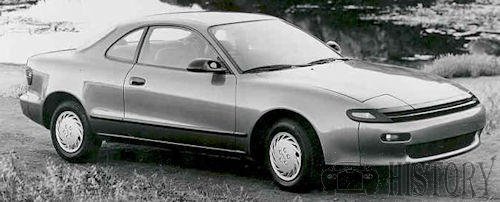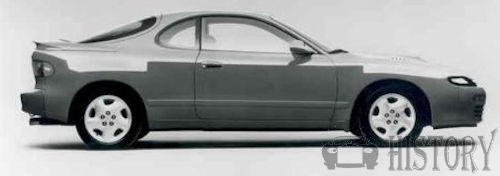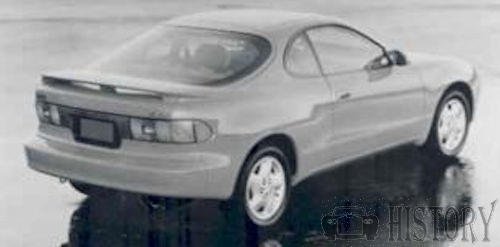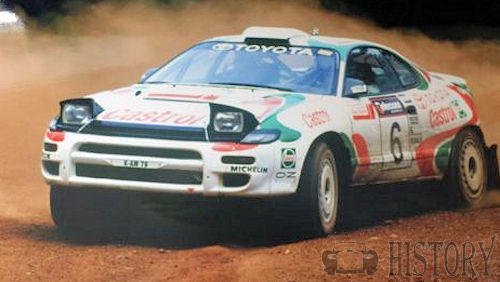Toyota Celica Fifth generation
| 1989 to 1993 | |
|---|---|
 |
|
| Overview | |
| Production | Sep 1989 – Sep 1993 |
| Assembly | Tahara, Aichi, Japan |
| Body and chassis | |
| Layout | Front engine, FWD / 4WD |
| Platform | T180 |
| Related | Toyota Carina ED Toyota Corona EXIV |
| Powertrain | |
| Engine | 1.6 L 4A-FE I4 2.0 L 3S-FE & 3S-GE I4 2.0 L turbo 3S-GTE I4 2.2 L 5S-FE I4 |
| Transmission | 4-speed automatic 5-speed manual |
| Dimensions | |
| Wheelbase | 2,525 mm (99.4 in) |
| Length | Coupe & Convertible: 176 in (4,470 mm) Normal body Liftback: 174 in (4,410 mm) Wide body Liftback: 174 in (4,420 mm) |
| Width | 1990 ST Coupe: 67 in (1,690 mm) Convertible, 1991–93 Coupe, Normal body Liftback: 67.1 in (1,705 mm) Wide body Liftback: 68.7 in (1,745 mm) |
| Height | Liftback FF: 1,280 mm (50.4 in) Coupe, Liftback 4WD: 1,290 mm (50.6 in) Convertible: 1,300 mm (51.2 in) |
The North American Celica had fixed door mirrors and amber front corner lights. All other models had folding mirrors and front clear corner lights. Driver's side SRS Airbag is standard on all US models. The base model ST has 1.6 L 4A-FE, the GT and GT-S were powered by the 2.2 L 5S-FE. The 1.6L was similar to the one used in the Corolla. The GT-S was rated 5 hp (4 kW) more than the GT at 135 bhp (101 kW; 137 PS). The 2.2 L was designed for more low-end torque, which appealled to US buyers' preferences as opposed to the high revving engines of the past. This engine was similar to the Camry's engine except for the balance shafts. The All-Trac Turbo was available with the improved 2.0 L 3S-GTE engine. It was rated at 200 bhp (149 kW; 203 PS) and 200 lb·ft (271 N·m) torque; an increase of 10 each from the previous model. The GT-S and all export market GT-Four are wide-body Liftbacks with flared fenders. The JDM GT-Four was also offered as normal body.

Trim levels for the European Celica were 1.6 ST-i, 2.0 GT-i 16, and GT-Four. The 2.0 GT-i 16 Cabriolet was offered only in certain European countries. Only the 2.0 GT-i 16 Liftback and GT-Four were officially sold in the UK. New for 1992, the wide body 2.0 GT-i 16 was offered in the Netherlands and Belgium. This was basically a GT-S with 3S-GE engine.
Models for Australia were SX Coupe, SX Liftback, GT-Four, and also 150 units limited edition GT-Four Group A Rallye. The Australian cars are less luxurious than JDM and North American models. Initially, the GT-Four did not come with ABS and fog lamps, which became standard few months after the introduction. In 1993, the Limited Edition WRC Trophy model was offered in Australia. This is basically the SX with sport front seats from the GT-Four, cruise control, rear window shade / spoiler, and special decals.
In August 1990, the wide body GT-Four A and Convertible were added into the Japanese Celica line up. Super Live Sound System with 10 speakers became standard on the GT-Four A and optional in other models except the S-R. The 20th Anniversary GT-R came in December 1990 to celebrate 20 years of Celica production. The Celica Convertible was built by American Sunroof Corporation (ASC) in California. It was offered as GT in US with 5S-FE engine, and as Type G in Japan or 2.0 GT-i 16 Cabriolet in Europe with 3S-GE engine. The JDM Convertible also has 4WS. The European Celica Cabriolet retained the old style front bumper for 1992, and received the facelift in 1993.
There are three different gearboxes for ST185 GT-Four. The E150F gearbox with 4.285 final gear ratio was installed in the JDM and All-Trac. European and Australian models, as well as the RC/Carlos Sainz/Group A models, came with the E151F gearbox with 3.933 ratio. The JDM only GT-Four Rally, a limited edition lightweight rally version sold only in Japan (not to be confused with the Australian GT-Four Grp A Rallye model), has the E152F gearbox with close ratio on the 1st through 4th gear and 4.285 final ratio. It also came with steel wheels and without air conditioning, power windows, or a power antenna. The early model GT-Four Rally is based on the normal body, and the facelift model is wide body with round fog lights. Also sold in Japan only was the GT-Four V. This is an economy version of normal body without alloy wheels, leather, or System 10, but still came with fog lights, power windows, and optional sunroof. This was not sold in Australia.
Anti-lock brakes (ABS) were available on the GT-S all four years and was available on the GT from 1992 to 1993. ABS, Leather interior, Sunroof, and System 10 Premium Sound System are optional on the GT-S and '90–'92 All-Trac, and standard on '93 All-Trac. With its sport-style interior, power-operated driver's seat, auto tilt-away steering wheel, and cruise control as standard equipment, the All-Trac (known as the GT-Four outside of the US) was the most expensive Celica yet. With a 2.0 L turbocharged 3S-GTE producing 149 kW (200 hp), it was the most powerful Celica ever sold in the USA.

In August 1991, Toyota face-lifted the Celica for the 1992 model year. Changes included:
- Stiffer anti-roll bar was added and suspension spring rates were increased.
- New three-way catalytic converter.
- Toyota (T) emblems on the hood and trunk.
- Taillights redesign (with smoke red frame).
- Improved gear linkage and a shorter gearshift.
- New 5S-FE, producing 100 kW (134 hp) and 196 N·m (145 lb·ft) of torque.
- Front discs were now 277 mm (10.9 in) and ventilated.
- The front-drive models (except for the North American GT-S, which used the same front bumper as the 4WD models) received a new style bumper;
- The export version GT-Four / All-Trac and GT-S retained automatic air conditioner, but the push button fan switch was replaced by the more conventional rotary type.
- North American GT models received standard fog lights.
- 15 in wheels on the Z-R, GT, and SX models fitted with Dunlop 205/55VR tires.
- Discontinued models: 4WS S-R, Active Sports, and normal body GT-Four.
- The 'A' was dropped from the 'GT-Four A' and the wide-body turbo model was simply known as the GT-Four.
- New round fog lights for the JDM GT-Four.
- The JDM only GT-Four Rally uses the wide body shell.
- The Cruise Control Package, SD Package and Luxury Package became optional on the JDM models.
For the Group A homologation, the special rally edition of 5000 units named GT-Four RC was launched in Japan in September 1991. The export models are called Carlos Sainz (CS) Limited Edition in Europe (in honour of their famous WRC driver), or Group A Rallye in Australia. Special features include:
- a different intercooler (water-to-air as opposed to air-to-air) which Toyota Team Europe wanted so they could more easily tune their WRC car.
- different hood, the emphasis of which is to get rid of heat as fast as possible (instead of scooping in air, as is the case with the standard ST185 hood).
- more aggressively tuned ECU.
- different bumper that is much lighter than the standard one.
Out of the 5000 units, 1800 stayed in Japan, 3000 for the selected European countries, 150 delivered to Australia, 25 went to Singapore, and a few were exported to New Zealand and other markets.

Technical
-
Toyota Celica 5th gen Technical details and specifications (1989–1993)
Dimensions:
Unladen weight: 4166 1b (1890 kg).
Length 174.4 in (4430 mm)
width 68.7 in (1745 mm).
height 51.2 in (1300 mm)
wheelbase 99.4 in (2525 mm).Transmission: 2.0 GT-Four
Four-wheel drive
five-speed manual gearbox Automatic, not available.Suspension:
Front, independent, MacPherson struts, anti-roll bar
Rear.independent, MacPherson struts, anti-roll bar.Steering:
Rack and pinion.
Power assistance: standard.Brakes:
Vented discs front
solid discs rear.
ABS: standard.Engine: 2.0 GT-Four
Front-mounted transverse four-cylinder
alloy head and twin ohc working four valves per cylinder
Electronic injection and turbocharger with air-air inter-cooler.
Bore 86.0 mm, stroke 86.0 mm
capacity 1998 cc.
Compression 8.8-to-l.
Catalyst: standard.Power: 2.0 GT-Four
Power 204 PS (150 kW) at 6000 rpm
torque 199 1b ft (275 Nm) at 3200 rpm.
Top gear speed at 1000 rpm: 28.5 mph (45.9 km/h)
Fuel consumption at constant 75 mph (120 km/h) : 37.1 mpg
Maximum speed 132 mph (212 km/h)
0 to 60 mph (97 km/h) 8.1 sec
80 mph (130 km/h) 13.9 sec.5th Generation Models Chassis code Model(s) Body style 2/4WS, FWD/4WD Engine Power Torque Markets AT180 ST-i (Europe), ST (North America, General) Coupe, Liftback 2WS, FWD 4A-FE 77 kW (103 hp) @ 6000 rpm 138 Nm (101tq) @ 3200 rpm Europe, North America, General ST182 2.0 GT-i 16 Liftback, Convertible 2WS, FWD 3S-GE 118 kW (158 hp) @ 6600 rpm 186 Nm (137tq) @ 4800 rpm Europe, Middle East ST182 2.0 GTS-i 16 Liftback wide body 2WS, FWD 3S-GE 118 kW (158 hp) @ 6600 rpm 186 Nm (137tq) @ 4800 rpm Belgium, The Netherlands ST183 Active Sports Liftback 4WS, FWD 3S-GE 118 kW (158 hp) @ 6600 rpm 186 Nm (137tq) @ 4800 rpm JP ST182 GT-R Liftback 2WS, FWD 3S-GE 118 kW (158 hp) @ 6600 rpm 186 Nm (137tq) @ 4800 rpm JP ST183 4WS GT-R Liftback 4WS, FWD 3S-GE 118 kW (158 hp) @ 6600 rpm 186 Nm (137tq) @ 4800 rpm JP ST182 Z-R Liftback 2WS, FWD 3S-GE 93 kW (125 hp) – JP ST183 4WS Z-R Liftback 4WS, FWD 3S-FE 93 kW (125 hp) – JP ST182 S-R Liftback 2WS, FWD 3S-FE 93 kW (125 hp) – JP ST183 4WS S-R Liftback 4WS, FWD 3S-FE 93 kW (125 hp) – JP ST184 GT (North America), SX (Australia) Coupe, Convertible (North America), Liftback 2WS, FWD 5S-FE 97 kW (130 hp) @ 5400 rpm 186 Nm (137tq) @ 4400 rpm US, Canada, Australia ST184 GT-S Liftback wide body 2WS, FWD 5S-FE 97 kW (130 hp) @ 5400 rpm 186 Nm (137tq) @ 4400 rpm North America, Thailand, Hong Kong ST185 GT-Four, GT-Four V Liftback normal body 2WS, 4WD 3S-GTE 165 kW (221 hp) @ 6000 rpm 270 Nm (199tq) @ 3200 rpm Japan ST185 GT-Four A, Turbo All-Trac Liftback wide body 2WS, 4WD 3S-GTE 149–165 kW (200–221 hp) @ 6000 rpm 270 Nm (199tq) @ 3200 rpm Japan, Europe, North America, Australia ST185 GT-Four RC, Turbo 4WD Carlos Sainz, GT-Four Grp A Liftback wide body 2WS, 4WD 3S-GTE 153–173 kW (205–232 hp) @ 6000 rpm 270 Nm (199tq) @ 3200 rpm Japan, Europe, Singapore, Australia
Service
-
Sevice Guide Toyota Celica 5th gen 1.6 2.0 liters
Engine codes: 4A-FE, 3S-GE, 3S-GTE
No. of cylinders Type 4/DOHC
Capacity 1587 cc
Compression ratio 9.5:1
Suitable for unleaded petrol Yes
Minimum octane rating 95 RON
Firing order 1-3-4-2
Spark plugs Original equipment NGK Type BCPR5EY
Electrode gap 0,8 mm
Fuel system System pressure 2.7-3.1 bar
Valve clearance -INLET 0,15-0,25mm cold
Valve clearance -EXHAUST 0,20-0,30mm cold
Oil pressure bar/rpm 2.5-4.9/3000
Drive belt size - alternator PV5x975 mm
Drive belt size - PAS/AC PV3x625 mm
Engine oil grade - cold climate 5W/30 SAE
Engine oil grade - normal climate 10W/30 SAE or 10W/40 SAE
Engine oil grade - hot climate 20W/50 SAE
Engine with filter 3.2 litres
Manual gearbox oil grade Dexron II SAE 2.7 litres
Cooling system 5.2 litres
Brake fluid Type DOT 3
Power steering fluid Type Dexron II 0.9 litres
Tighten Road wheels 103 Nm
Tighten Spark plugs 18 Nm
Maximum cranking amps 162-198
Alternator Type 70A
Regulated voltage 13.9-15.1 VToyota Model: Celica 2,0 Engine code: 3S-GE specific
No. of cylindersType 4/DOHC
Capacity 1998cc
Compression ratio 10.0:1
Firing order 1-3-4-2
Spark plugs Original equipment NGK Type BKR6EYA
Spark plug Electrode gap 0.8-1.1 mm
Fuel system System pressure 2.7-3.1bar
Thermostat opens 80-84°C
Engine with filter 3,9 litres
Cooling system 6,0 litresToyota Model: Celica 2,0 GT4 Engine code: 3S-GTE specific
No. of cylinders Type 4/DOHC
Capacity 1998 cc
Compression ratio 8.8:1
Firing order 1-3-4-2
Spark plugs Original equipment NGK Type BKR6EYA
Electrode gap 0.8 mm
Fuel system System pressure 2.3-2.7bar
Valve clearance -INLET 0.15-0.25mm cold
Valve clearance -EXHAUST 0,20-0,30mm cold
Oil pressurebar/rpm 2.5-4.9/3000
Radiator cap 0.74-1.03 bar
Thermostat opens 80-84°C
Engine with filter 4.5 litres
Cooling system 6,0 litresTyres : 215/50 VR 15.
Fuel tank: 13.2 Imp. gall (60 litres)© motorcar history
